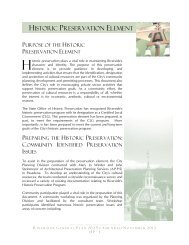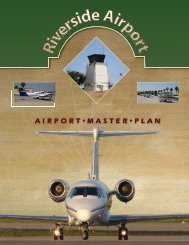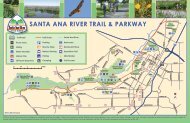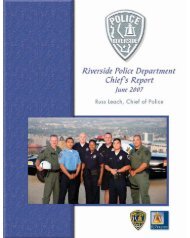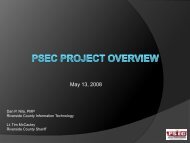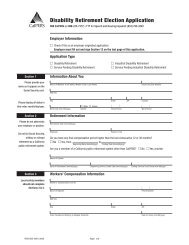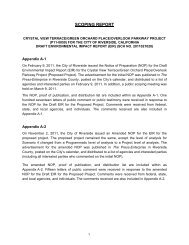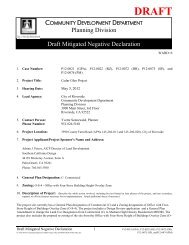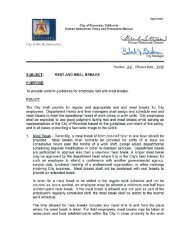Northside - City of Riverside
Northside - City of Riverside
Northside - City of Riverside
Create successful ePaper yourself
Turn your PDF publications into a flip-book with our unique Google optimized e-Paper software.
style were constructed from 1915 to 1940, but in <strong>Riverside</strong>, most examples are<br />
typically from the 1920s and 1930s, a time when period revival architecture<br />
dominated construction styles. The Spanish Colonial Revival style was mastered by<br />
such well-known local architects as Robert H. Spurgeon, Jr., Henry L.A. Jekel, and G.<br />
Stanley Wilson, although most examples were constructed by local builders.<br />
Character-defining features <strong>of</strong> the style include square or rectangular plans, a low-<br />
ro<strong>of</strong> topped with red tiles, and close eaves. Arches are common above doors<br />
pitched<br />
and prominent windows, and walls are sheathed in smooth stucco. Round or square<br />
towers are sometimes present, and decorative details include patterned tiles,<br />
scalloped parapets, and the use <strong>of</strong> wrought iron grille work (McAlester 2000:417-18).<br />
Tudor Revival<br />
Loosely based on late medieval examples, the Tudor Revival style rose in popularity<br />
after World War I and dominated early 20 th century suburban landscapes. Most<br />
popular in the 1920s and early 1930s, this style features steeply pitched, typically<br />
cross-gabled ro<strong>of</strong>s and groups <strong>of</strong> tall, narrow windows. Decorative elements <strong>of</strong>ten<br />
include half-timbering, arches, massive chimneys, and sometimes quoins. Walls can<br />
be clad in a variety <strong>of</strong> materials, including brick, wood, stucco, or stone. Popularity<br />
<strong>of</strong> the style faded in the late 1930s with the rise <strong>of</strong> the modern period (McAlester<br />
2000: 355-56).<br />
Pueblo Revival<br />
A blend <strong>of</strong> Native American designs and the Spanish Colonial Revival style, the<br />
Pueblo Revival is most common in the southwest region <strong>of</strong> the United States.<br />
Although most popular in the 1920s and 1930s, the Pueblo Revival style is not a<br />
common one <strong>of</strong> the Eclectic period, and surviving examples remain scattered. A flat<br />
ro<strong>of</strong> with stepped or rounded parapet walls, the use <strong>of</strong> stucco, and the presence <strong>of</strong><br />
vigas, or wooden ro<strong>of</strong> beams, characterize the style.<br />
Monterey Revival<br />
Unique to the survey area and rare to <strong>Riverside</strong>, one example (4428 Houghton<br />
Avenue) designed by Henry L.A. Jekel in the Monterey Revival style is found in the<br />
proposed North Hill Historic District. Given the style’s free interpretation <strong>of</strong> the<br />
Spanish Colonial Revival style and the architect’s bias for the Spanish style, it is not<br />
surprising to see many Spanish details on this residence. Character-defining features<br />
<strong>of</strong> the Monterey are hard to classify, but one clear feature is the second-floor balcony<br />
covered by the main ro<strong>of</strong> form, which is present in this example. Other features<br />
include paired windows and the use <strong>of</strong> faux shutters, and while the residence<br />
displays paired fenestration, the arched, tripartite window assemblage on the right<br />
façade mimics the image <strong>of</strong> a large window flanked with shutters. Unlike the<br />
113



